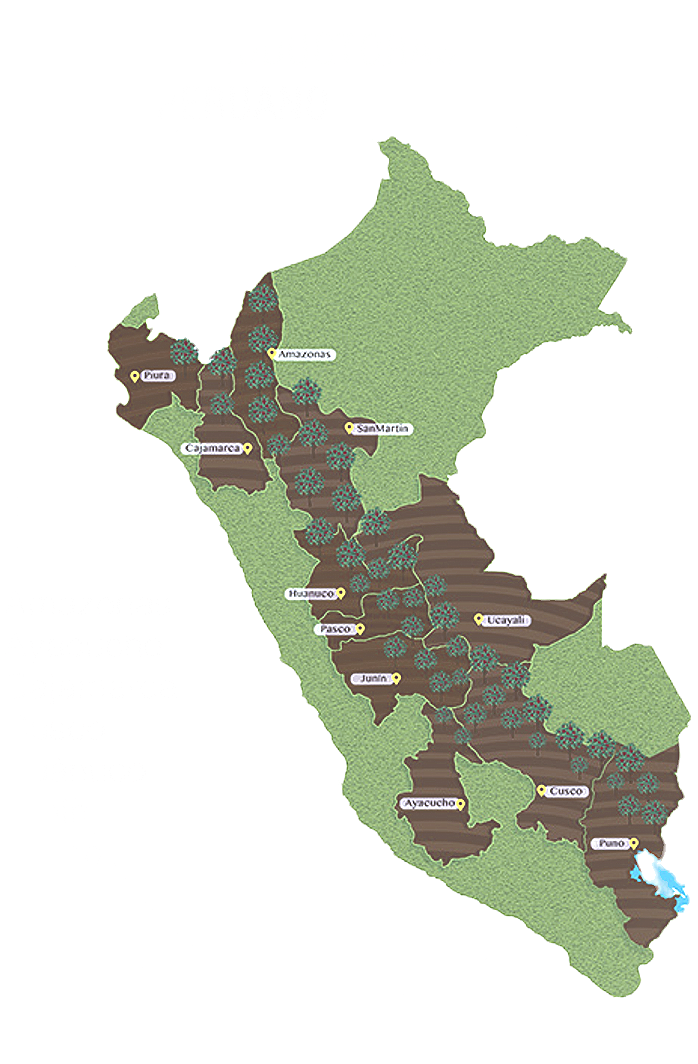Peruvian Coffee: A Global Leader in Flavor, Quality, and Sustainability
Peruvian coffee is recognized in the global specialty coffee market for its bright acidity, complex flavor profiles, and sustainable production methods. Located in the western part of South America, Peru’s diverse geography, high altitudes, ideal climate, and fertile soil make it one of the world’s most promising regions for cultivating high-quality Arabica coffee. Since coffee was introduced in the 18th century, Peru has gradually become a key origin in the global Arabica supply chain.
Today, Peru has approximately 223,000 coffee-farming households, and over one million people depend directly on the coffee industry for their livelihoods. With 425,000 hectares of land dedicated to coffee cultivation (CENAGRO 2012), coffee is one of Peru’s most significant agricultural exports.
Peru Coffee: A Global Organic Leader

The coffee sector supports the economic development of 11 major coffee-growing regions, most of which are driven by smallholder farmers who follow organic and sustainable farming practices. Peru ranks as the 9th largest coffee producer in the world, and proudly holds the title of the No.1 exporter of organic coffee globally. In terms of Arabica coffee exports, Peru stands 5th worldwide, showcasing its strength in traceability, quality, and environmental responsibility.

📍 Puno
Flavor Profile: Citrus, Spices, Honey
Growing Altitude: 1,400 – 2,000 meters
Characteristics: Coffee from Puno is grown in the high-altitude regions of the Andes, offering a delicate flavor profile that often receives high scores in cupping evaluations.
📍 Piura
Flavour characteristics: berry, floral, molasses
Planting altitude: 1,000 – 1,800 meters
Features: Piura is famous for its Pink Bourbon
The coffee is famous for its bright acidity and rich flavor.
📍 Cajamarca
Flavor Profile: Floral, Berries, Brown Sugar
Growing Altitude: 1,200 – 2,000 meters
Characteristics: One of Peru's most well-known specialty coffee regions,
Cajamarca is favored in the specialty market for its bright acidity and sweetness.
📍 Huánuco
Flavor Profile: Stone Fruits, Spices, Caramel
Growing Altitude: 1,300 – 1,800 meters
Characteristics: Coffee from this region mainly comes from small-scale farms, offering a mild flavor with pronounced sweetness.
📍 Pasco
Flavor Profile: Citrus, Cocoa, Stone Fruits
Growing Altitude: 1,400 – 1,900 meters
Characteristics: With more variable climate conditions, coffee production is limited in Pasco, but the flavor profile is delicate and refined.
📍 Junín
Flavor Profile: Tropical Fruits, Chocolate, Vanilla
Growing Altitude: 1,000 – 1,800 meters
Characteristics: Junín is one of Peru’s major coffee production regions, with the Chanchamayo area located here, known for its high-quality washed coffees.
📍 Amazonas
Flavor Profile: Citrus, Red Fruits, Chocolate 🌱
Growing Altitude: 1,200 – 1,800 meters
Characteristics: This region has fertile soil, making it ideal for washed processing. The coffee has a clean mouthfeel and a balanced flavor.
📍 San Martín
Flavor Profile: Tropical Fruits, Honey, Chocolate
Growing Altitude: 1,200 – 1,800 meters
Characteristics: This region focuses on organic farming and employs eco-friendly agricultural techniques.
📍 Ucayali
Flavor Profile: Cocoa, Nuts, Caramel
Growing Altitude: 800 – 1,600 meters
Characteristics: Located in the Amazon Basin, the unique growing conditions result in coffee with a fuller body and a rich cocoa profile.
📍 Cusco
Flavor Profile: Citrus, Cocoa, Red Fruits
Growing Altitude: 1,500 – 2,200 meters
Characteristics: The high-altitude growing environment in Cusco gives the coffee a complex flavor profile with a refreshing acidity.
📍 Ayacucho
Flavor Profile: Nuts, Caramel, Citrus
Growing Altitude: 1,400 – 1,900 meters
Characteristics: Coffee from Ayacucho is relatively rare, primarily grown by small farmers and processed using traditional hand methods.

Peru Cocoa Beans
Peru cocoa has a rich and ancient legacy that stretches back more than 3,000 years—long before the Inca Empire. Early civilizations such as the Moche and Chavín cultivated cocoa and revered it as a sacred crop. Archaeological findings in northern Peru have uncovered cocoa residues, proving that the region has been home to cocoa cultivation for millennia. Inspired by the traditions of the Maya and Aztec in Mesoamerica, cocoa became central to indigenous Andean rituals and trade.
When the Spanish colonizers arrived in the 16th century, they brought Peruvian cocoa to Europe, sparking the beginning of chocolate’s global journey. While cocoa cultivation in Peru remained limited during the colonial era—overshadowed by regions like Venezuela and Mexico—it expanded significantly in the 18th century, especially in the fertile zones where the Amazon Basin meets the Andes, such as San Martín, Junín, and Amazonas.
Through the 20th century, Peru’s cocoa industry faced challenges, but in the 21st century, the rise of the fine chocolate market transformed the outlook. Global demand surged for single-origin, organic, and ethically sourced cocoa, creating new opportunities for Peruvian farmers.
Today, Peru ranks as the 9th largest cocoa producer in the world and is one of the top exporters of organic cocoa. Smallholder farmers and cooperatives across the country champion fair trade, rainforest protection, and sustainable farming practices, while refining fermentation and post-harvest techniques that highlight the unique flavor profiles of Peruvian cocoa beans.
With its ancient heritage, diverse genetic varieties, and distinctive terroir, Peruvian cocoa is now a global favorite in the fine chocolate industry. From sacred rituals to modern indulgence, Peru cocoa delivers deep cultural richness and exceptional taste, captivating chocolate lovers worldwide.

Forastero
-
Over 80% of the world's chocolate comes from this type of bean
-
Grows quickly
-
Strong disease resistance
-
Rounder than Criollo, with shallower grooves
-
Color ranges from yellow to orange, with purple beans
-
Bitter taste

Criollo
-
White to light pink color
-
The pods are red or yellow (sometimes blue)
-
Long-shaped with grooves
-
Complex flavor; fruity or spicy aroma
-
Very little bitterness

Trinitario
-
A hybrid of Criollo and Forastero
-
Highly versatile
-
Has the flavor profile of Criollo
and the robustness of Forastero